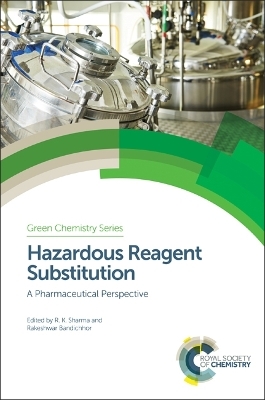
Hazardous Reagent Substitution
A Pharmaceutical Perspective
Seiten
2017
Royal Society of Chemistry (Verlag)
978-1-78262-050-1 (ISBN)
Royal Society of Chemistry (Verlag)
978-1-78262-050-1 (ISBN)
Showing how the pharmaceutical industry has adopted green chemistry, this book is of interest to industrialists working in pharmaceuticals and researchers working in green chemistry.
In recent years, a significant amount of progress has been made using green chemistry in the synthesis of synthetically useful compounds and molecules by replacing hazardous chemicals with greener alternatives. However, there is still room for improvement, especially in the pharmaceutical sector where new drugs are being formulated. This book examines green approaches to overcoming hazardous organic transformations. Summarizing recent developments, the book features a detailed description of some of the high impact active pharmaceutical ingredients that have been developed considering green chemistry approaches. It explores the design, engineering and process development and the calculations to account for waste. The book includes strategies to further advance green approaches in the development of generic pharmaceutical industries and features novel, innovative approaches that promote waste-free organic synthesis. This book is of interest to industrialists working in pharmaceuticals and researchers working in green chemistry.
In recent years, a significant amount of progress has been made using green chemistry in the synthesis of synthetically useful compounds and molecules by replacing hazardous chemicals with greener alternatives. However, there is still room for improvement, especially in the pharmaceutical sector where new drugs are being formulated. This book examines green approaches to overcoming hazardous organic transformations. Summarizing recent developments, the book features a detailed description of some of the high impact active pharmaceutical ingredients that have been developed considering green chemistry approaches. It explores the design, engineering and process development and the calculations to account for waste. The book includes strategies to further advance green approaches in the development of generic pharmaceutical industries and features novel, innovative approaches that promote waste-free organic synthesis. This book is of interest to industrialists working in pharmaceuticals and researchers working in green chemistry.
Rakesh Kumar Sharma is Professor and Coordinator of Green Chemistry Network Centre, University of Delhi, India. Rakeshwar Bandichhor is an Associate Director at Dr. Reddy's Laboratories, India.
Introduction to Hazardous Reagent Substitution in the Pharmaceutical Industry;
Recyclability of Reagents;
Recoverable Polymer-supported DMAP Derivatives;
Synthesis of Atorvastatin;
Synthesis of Raloxifene;
Synthesis of Montelukast;
Development of a Safe, Scalable, Azide-free Synthesis of 1-Aryl-1H-tetrazoles Using Diformylhydrazine;
New Directions from Academia
| Erscheinungsdatum | 17.03.2018 |
|---|---|
| Reihe/Serie | Green Chemistry Series ; Volume 52 |
| Verlagsort | Cambridge |
| Sprache | englisch |
| Maße | 156 x 234 mm |
| Gewicht | 461 g |
| Themenwelt | Medizin / Pharmazie ► Medizinische Fachgebiete ► Pharmakologie / Pharmakotherapie |
| Naturwissenschaften ► Biologie ► Ökologie / Naturschutz | |
| Naturwissenschaften ► Chemie ► Organische Chemie | |
| ISBN-10 | 1-78262-050-8 / 1782620508 |
| ISBN-13 | 978-1-78262-050-1 / 9781782620501 |
| Zustand | Neuware |
| Haben Sie eine Frage zum Produkt? |
Mehr entdecken
aus dem Bereich
aus dem Bereich
Arzneimittelverzeichnis für Deutschland (einschließlich …
Buch | Hardcover (2024)
Rote Liste Service GmbH (Verlag)
CHF 149,95
Englisch für Apotheker und PTAs
Buch | Spiralbindung (2024)
Kohlhammer (Verlag)
CHF 44,75


